

HQ2. - The Washington Post. The Men Peddling the 'Secrets' to Getting Rich on Amazon. What I Learned from Jeff Bezos After Reading Every Amazon Shareholder Letter - Parsa Saljoughian - Pocket. In every Amazon annual report, Jeff Bezos publishes a shareholder letter where he provides a broad overview of the company’s operations throughout the year.
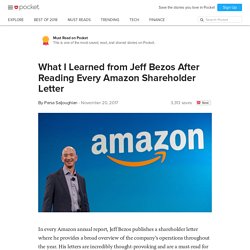
His letters are incredibly thought-provoking and are a must-read for anyone working in tech or interested in business. Bezos knows how to communicate with Wall Street and is both clear and concise in his writing. Recently, I discovered a link that included the complete set of these letters (from 1997 to 2016) in one handy PDF. Here are a few of my key takeaways from reading through it.
S Use of Your Data. Real estate technology will soon compress buying, selling, and renting in an app. This story is part of What Happens Next, our complete guide to understanding the future.
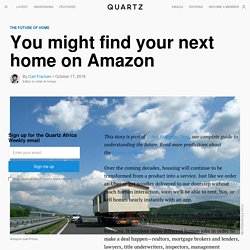
Read more predictions about the Future of Home. Over the coming decades, housing will continue to be transformed from a product into a service. Just like we order an Uber or get noodles delivered to our doorstep without much human interaction, soon we’ll be able to rent, buy, or sell homes nearly instantly with an app. This will be a profound change for the residential real-estate industry, which has historically been a “people-driven” business. It involves many different human jobs in order to make a deal happen—realtors, mortgage brokers and lenders, lawyers, title underwriters, inspectors, management companies—and has been surprisingly resistant to the kind of tech-led “disruption” and automation that has overturned other industries. What Amazon’s Black Friday shift is like for workers. Last year, shoppers spent $7.9 billion on Thanksgiving Day and Black Friday.
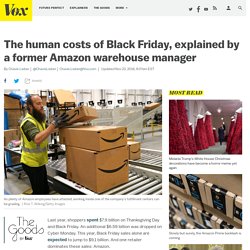
An additional $6.59 billion was dropped on Cyber Monday. This year, Black Friday sales alone are expected to jump to $9.1 billion. And one retailer dominates these sales: Amazon. Last year, Amazon accounted for 45 percent of all Thanksgiving Day online purchases and 60 percent of purchases on Black Friday, according to Hitwise. Our new column from inside Amazon: 'They treat us as disposable' Welcome Amazonians.

It is always Day 1. Are you ready to make a difference? It was my first day as a seasonal Amazon worker, hired just prior to peak season. Our site operations manager was like many Amazon managers: an ex-military white male, in his late 40s and wearing straight-fit jeans and a T-shirt with “Amazon Military” emblazoned on the front. He drew a line alongside an inverted pyramid, writing “least important” on the bottom and “most important” higher up, with the word “customer” scrawled along the very top.
The New York Hustle of Amazon’s Second Headquarters. The city of hustlers got hustled.
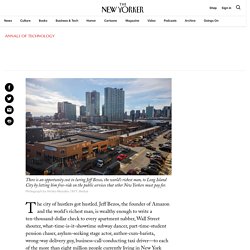
Jeff Bezos, the founder of Amazon and the world’s richest man, is wealthy enough to write a ten-thousand-dollar check to every apartment nabber, Wall Street shouter, what-time-is-it-showtime subway dancer, part-time-student pension chaser, asylum-seeking stage actor, author-cum-barista, wrong-way delivery guy, business-call-conducting taxi driver—to each of the more than eight million people currently living in New York City. This week, though, when Bezos bestowed upon the city the dubious honor of becoming Amazon’s second “headquarters”—an honor it shares with two other cities, including its existing headquarters, in Seattle—it was New Yorkers who paid him. How Amazon’s retail revolution is changing the way we shop. In the course of a single generation, Amazon has grown from fledgling online bookseller to one of the most valuable and powerful corporations in modern history.

The empire of CEO Jeff Bezos has grown so vast that critics, overseas regulators, and Washington politicians are all now wondering whether the company has become an unstoppable force, and what, if anything, is capable of reining in its reach. A recent spat with Sen. Why Amazon’s future depends on moving from the internet to the physical world. The future of Amazon is starting to look a lot more complicated than just selling products on the internet.

One of the company’s cashier-less Go convenience stores opened in San Francisco last week, with another store opening in the city later this year and more planned for Chicago and New York City in 2019. Coupled with Amazon’s purchase of Whole Foods last year, these Go stores give us a glimpse into a future hybrid form of retail that Amazon could use to expand from e-commerce into real-world purchases at restaurants, grocery stores, and elsewhere. Understanding why the company is interested in those sectors, and what its real competitors are, is the key to understanding how we buy everything in the future is beginning to change.
Amazon CEO Jeff Bezos has always set out to build the Everything Store, but it’s increasingly clear that to accomplish that, Amazon will have to become the do-everything company. But October was less rosy. Amazon's $15 Minimum Wage Could Shake Up the Economy. Second, there is the economic-fundamentals theory.
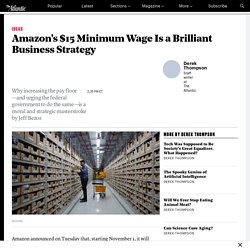
That is, Amazon is raising wages not because of political pressure, but because of wage pressure. In a tightening labor market, with unemployment at less than 4 percent, it’s becoming more difficult for companies to hire and retain low-income workers. This is particularly true in warehousing, where work can be grueling and wages are rising twice as fast as the national average. A strong piece of evidence for the economic-fundamentals theory is that Amazon isn’t the only company to raise its minimum wage since the unemployment rate has been hovering around 4 percent. Bloomberg. The Day I Drove for Amazon Flex. But Flex operates year-round, not just during the holiday season, which suggests there’s another reason for it: It’s cheap.
As the larger trucking industry has discovered over the past decade, using independent contractors rather than unionized drivers saves money, because so many expenses are borne by the drivers, rather than the company. Amazon has rolled out Flex in more than 50 cities, including New York; Indianapolis, Indiana; and Memphis, Tennessee. Welcome to Blaine, the town Amazon Prime built.
Jeff Bezos v the world: why all companies fear 'death by Amazon' The computer on which this article was written is sitting on a laptop stand that tells you everything you need to know about how Amazon does business.

At $19.99 (£14.99) a pop, the laptop stand combines everything customers love about Amazon: utility, price and convenience. It’s also a total and complete knockoff – of a laptop stand that the San Francisco-based company Rain Design began selling nearly a decade before Amazon decided to make its own. Amazon’s innovation with its own version was to replace Rain Design’s raindrop logo with its own smiley arrow logo – and cut the price in half. Amazon Has a Top-Secret Plan to Build Home Robots. Ten years ago, Amazon introduced the Kindle and established the appeal of reading on a digital device.
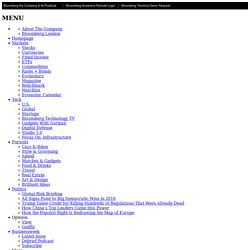
Four years ago, Jeff Bezos and company rolled out the Echo, prompting millions of people to start talking to a computer. Now Amazon.com Inc. is working on another big bet: robots for the home. A Small Town Kept Walmart Out. Now It Faces Amazon. GREENFIELD, Mass. —Al Norman has been fighting to keep Walmart and other big-box retailers out of small towns like this one for 25 years. He’s been successful in Greenfield, his hometown and the site of his first battle with Walmart, and in dozens of other towns across the country—victories he documents on his website Sprawl-Busters, an “International Clearinghouse on Big Box Anti-Sprawl Information.”
Partly because of Norman’s efforts to keep out such stores, Greenfield still has a Main Street with dozens of businesses, including a bookstore, a record store, and Wilson’s, one of the last independently owned department stores in the country. How Amazon Became Corporate America’s Nightmare. Amazon makes no sense.
It’s the most befuddling, illogically sprawling, and—to a growing sea of competitors—flat-out terrifying company in the world. It sells soap and produces televised soap operas. It sells complex computing horsepower to the U.S. government and will dispatch a courier to deliver cold medicine on Christmas Eve. The Design Theory Behind Amazon’s $5.6 Billion Success. From an aesthetic point of view, Amazon’s web store is neither simple nor beautiful–two things we expect of good design.
Instead, it focuses on simplicity of experience, process, and functionality. For many designers, the idea that an experience with Amazon’s visual complexity succeeds is somewhat confounding. So, how might a designer look at Amazon to understand why it works, despite—if not because of—its aesthetic? Amazon-cuts-shipping-costs-freight. Before you consciously became aware of your decision to read this article, your brain was already making the necessary preparations to click the link.
There are a few crucial milliseconds between the moment when you’re consciously aware of a plan to act, and the moment you take action. This brief window is thought by some scientists to be the moment in time when we can exercise free will. It gives us the chance to consciously make a decision, suggesting we aren’t just slaves to our impulses. But, as the New Scientist reports, a study published in Neuroscience of Consciousness last year found that impulsive people have a shorter window of time between their awareness of an impending action and the act itself.
Emilie Caspar and Axel Cleeremans from the Free University of Brussels asked 72 people to fill out surveys to determine their level of impulsivity.